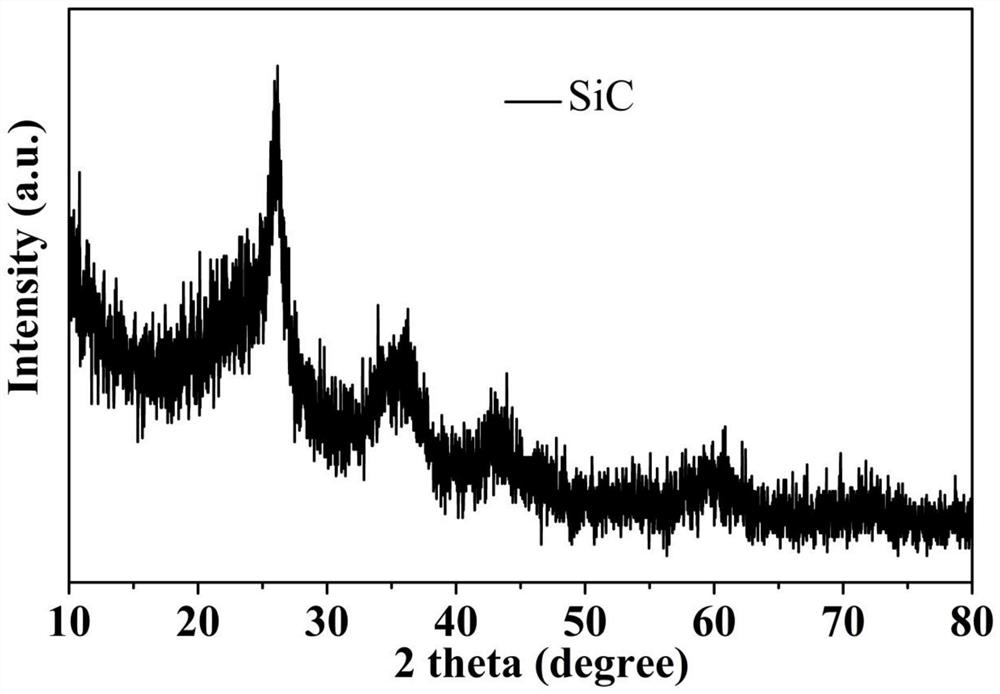Preparation of sic fiber by mixing ultra-high temperature ceramic composite material and its method and application
A technology of ultra-high temperature ceramics and composite materials, applied in the direction of inorganic raw material rayon, etc., can solve the problems of poor bending and shearing resistance, prone to cracks, carbon-rich, etc. High temperature performance, the effect of improving the degree of densification
- Summary
- Abstract
- Description
- Claims
- Application Information
AI Technical Summary
Problems solved by technology
Method used
Image
Examples
Embodiment 1
[0019] Embodiment 1 proposes a method for preparing SiC fibers by adding ultra-high temperature ceramic composite materials, including the following steps:
[0020] (1) First add glycerol and trimethylmonochlorosilane dropwise in dimethyldichlorosilane with stirring, then add reaction metal and xylene, then heat to 100°C to melt the reaction metal into a liquid state and stir When the solution turns purple, reduce the temperature to room temperature until the purple is no longer deep, then cool and filter, wash with alcohol for 3 times, dry and grind into powder; among them, dimethyldichlorosilane, glycerol and trimethyl The volume ratio of monochlorosilane is 10:2:1; the reaction metal is potassium or magnesium, the reaction metal accounts for 13% of the mass of the reactant, and xylene accounts for 5% of the total volume of the reactant.
[0021] (2) Polydimethylsilane, polymer organo-zirconane, polymer organoboroaluminum-zircone and polycarbosilane are mixed according to th...
Embodiment 2
[0024] Embodiment 2 proposes a method for preparing SiC fibers by adding ultra-high temperature ceramic composite materials, including the following steps:
[0025] (1) First add glycerol and trimethylmonochlorosilane dropwise in dimethyldichlorosilane with stirring, then add reaction metal and xylene, then heat to 150°C to melt the reaction metal into a liquid state and stir When the solution turns purple, reduce the temperature to room temperature until the purple is no longer deep, then cool and filter, wash with alcohol for 3 times, dry and grind into powder; among them, dimethyldichlorosilane, glycerol and trimethyl The volume ratio of monochlorosilane is 10:2:1; the reaction metal is potassium or magnesium, the reaction metal accounts for 7% of the mass of the reactant, and xylene accounts for 8% of the total volume of the reactant.
[0026] (2) Polydimethylsilane, polymer organo-zirconane, polymer organoboroaluminum-zircone and polycarbosilane are mixed according to the...
Embodiment 3
[0029] Embodiment 3 proposes a method for preparing SiC fibers by adding ultra-high temperature ceramic composite materials, including the following steps:
[0030] (1) First add glycerol and trimethylmonochlorosilane dropwise in dimethyldichlorosilane with stirring, then add reaction metal and xylene, then heat to 125°C to melt the reaction metal into a liquid state and stir When the solution turns purple, reduce the temperature to room temperature until the purple is no longer deep, then cool and filter, wash with alcohol for 3 times, dry and grind into powder; among them, dimethyldichlorosilane, glycerol and trimethyl The volume ratio of monochlorosilane is 10:2:1; the reaction metal is potassium or magnesium, the reaction metal accounts for 10% of the mass of the reactant, and xylene accounts for 6% of the total volume of the reactant.
[0031] (2) Polydimethylsilane, polymer organo-zirconane, polymer organoboroaluminum-zircone and polycarbosilane are mixed according to th...
PUM
 Login to View More
Login to View More Abstract
Description
Claims
Application Information
 Login to View More
Login to View More - R&D
- Intellectual Property
- Life Sciences
- Materials
- Tech Scout
- Unparalleled Data Quality
- Higher Quality Content
- 60% Fewer Hallucinations
Browse by: Latest US Patents, China's latest patents, Technical Efficacy Thesaurus, Application Domain, Technology Topic, Popular Technical Reports.
© 2025 PatSnap. All rights reserved.Legal|Privacy policy|Modern Slavery Act Transparency Statement|Sitemap|About US| Contact US: help@patsnap.com

